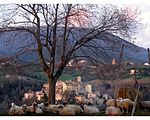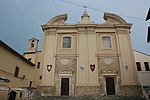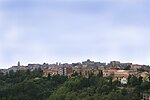Forum Novum

Forum Novum (later also called Vescovìo) was a new Roman foundation which developed as a forum or market center during the Roman Republic period. By the early 1st century AD Forum Novum had been elevated to the status of municipium, appearing as such in Pliny's list of towns. It is located within today’s commune of Torri in Sabina in the province of Rieti.Knowledge of the history of the centre comes largely from literary sources and the rich epigraphic evidence. Forum Novum seems to have functioned throughout the imperial period and a market was still being held at the center in the fourth century. Although urban life probably underwent a decline around this period, Forum Novum, later Vescovio, continued to act as a local and regional focus with the establishment of a bishopric in the fifth century, a role it maintained throughout the early medieval and medieval periods; it remains a titular see in the Catholic Church today. Little systematic archaeological work has been carried out on the centre or its valley. Excavations carried out by the Soprintendenza Archeologica per il Lazio in the late 1970s and early 80s revealed the basilica, a temple complex, part of the forum and various associated buildings of uncertain function. The results have never been fully published.
Excerpt from the Wikipedia article Forum Novum (License: CC BY-SA 3.0, Authors, Images).Forum Novum
Via Romana vecchia,
Geographical coordinates (GPS) Address Nearby Places Show on map
Geographical coordinates (GPS)
| Latitude | Longitude |
|---|---|
| N 42.330555555556 ° | E 12.603888888889 ° |
Address
Rovine dell'antico municipio romano di Forum Novum
Via Romana vecchia
Lazio, Italy
Open on Google Maps







